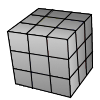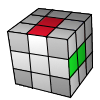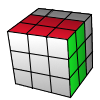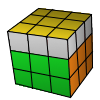Cubing Terminology
Abbreviations and Commonly Used Expressions
With any hobby, there are a lot of phrases and terms used and known only by the hobbyists themselves. Cubing is no exception to this, as there are several phrases, abbreviations or inside-jokes used commonly in the cubing world that most people might not understand. Some are fairly obvious and/or used in other hobbies, however most are unique to speedcubing.
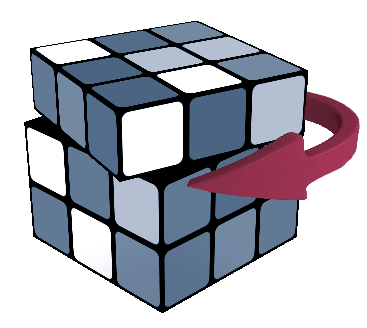
U - clockwise rotation of the upper layer
- 1PB
- 2DNF
- 3Ao5, Ao12
- 4F2L, OLL, PLL
- 5Colour Neutrality
- 6Look-Ahead
- 7Events: BLD, MBLD, OH, FMC
- 8Scramble
- 9NR, CR, UWR, YTWR and WR
- 10WCA Events / Non-WCA Events
- 11Sub-X solve or average
- 12Advanced Puzzle Notation
- 13Roux Method
- 14Inspection
- 15Relays
- 16Real Man Events
- 17Guildford Challenge
- 18Factory Solves
- 19Team BLD
PB (Personal Best)
If a speedcuber solves a puzzle faster than they have ever done before, it is known as a PB or personal best. Most speedcubers have a text document or Excel spreadsheet somewhere with their PB’s for every event. These can be PB Single (best individual solve ever) or for one of the averages listed below.
DNF (Did Not Finish)
You get this penalty when you don't finish the cube inspection in 15 seconds or the cube is not in solved position when you stop the timer.
Ao5, Ao12 etc. (Average of …) and Mo3 (Mean of 3)
Single solves in speedcubing can be quite lucky. Therefore, most of the bragging rights within the community go to the best averages solvers can achieve. An Average of 5 (Ao5) is calculated using any five consecutive solves. The fastest and slowest times in the average are removed (to remove any ridiculously fast or slow solves that may have occurred and would bring the average higher or lower) and then a mean is calculated with the final 3 solves. The Average of 12 is calculated the same way, with the middle 10 solves being used. A Mean of 3 is generally used in competitions for puzzles that take even the fastest solvers several minutes to complete. This is similar to the average of 5 concept, however only 3 solves are performed and, regardless of the standard deviation, a mean is calculated with those three solves.
Any steps within the Fridrich method (Cross/Plus, F2L, OLL, PLL)
The Fridrich (or CFOP) method is the most commonly used speedsolving method due to its efficiency, simplicity and low-algorithm knowledge requirements. Cross is the first step in this method where four edges are placed intuitively on the correct face. F2L stands for First 2 Layers. This step involves inserting “pairs” of corners and edges into the spaces around the four edges dependent on the centres. OLL stands for Orientation of the Last Layer. Once the first two layers are solved, only the top faces’ pieces will remain. Orientation involves using a previously memorised algorithm to get the same colour facing up on every piece. PLL stands for Permutation of the Last Layer, and this simply involves performing another algorithm to move the pieces around on the top layer whilst maintaining the colour on top, solving the puzzle.
Other methods use different abbreviations and step names, but since CFOP is the most popular method, it is the only one you are most likely to hear about.
Colour Neutrality
This is a fairly simple phrase that refers to which colour the solver begins their cross (see above) on. Most speedcubers stick to one colour only, as it makes recognition much easier, however colour neutrality means that the solver is able to create the cross on any colour, and therefore has 6 different options for cross to pick from(this helps avoid difficult and lengthy cross solutions on other colours)
Look-Ahead
This is a common expression used as advice to everyone who wants to get faster at solving the puzzle. The F2L stage of a Fridrich solve is the most move intensive and time requiring stage. Therefore, this is the main area that speedcubers try to improve (OLL and PLL are simply memorising algorithms into muscle-memory and the cross is fairly simple and not too time consuming). Looking Ahead refers to building the pairs of edges and corners to be inserted around the cross, and how efficiently this can be done. Since there are four pairs to be made, general advice is to be looking for the next edge and corner piece that you’re going to build as you’re inserting the one that you have just built. It sounds incredibly difficult but over time, speedcubers will memorise most F2L cases and be able to execute them without a second look.
Event Acronyms (BLD, MBLD, OH, FMC)
These are simply acronyms that refer to events hosted by the WCA (World Cube Association) in competitions. BLD stands for Blindfolded, where the solver memorises positions of pieces on a puzzle before donning a blindfold and solving the puzzle. 4BLD and 5BLD are similar, but with 4x4 and 5x5 cubes respectively. MBLD stands for multi-blindfolded where the competitor memorizes many 3x3 cubes, then solves all of them with his eyes closed. OH stands for One Handed, which you can probably guess. FMC stands for Fewest Move Count, where solvers try to solve the puzzle in an hour using the fewest moves possible.
Scramble (and simple cubing notation)
A scramble is another simple term that, for a 3x3 cube, consists of 20 randomly generated moves in standard notation that will leave the cube in an unsolved state ready for a solver to attempt. Cubing Notation involves the letters R, U, L, D, B and F to refer to the different faces of the puzzle (Right, Up, Left, Down, Back and Front respectively). Any of these letters (I’ll be using R as an example) can come in three forms – R, R’ or R2. The letter on its own refers to a clockwise turn of that layer 90 degrees. The apostrophe after the letter refers to a counter clockwise turn by 90 degrees. Finally, the number 2 after the letter refers to a 180 degree turn in either direction (the result will be the same). This same notation is used in both FMC (see above) and solve reconstructions to show how the solver got from an unsolved state to a solved one.
They use computer generated puzzle scrambles on official competitions to provide equal chances to the competitors.
NR, CR, UWR, YTWR and WR
These stand for the different records available to speedsolvers in official competitions. NR stands for National Record, CR stands for Continental Record, and WR stands for World Record. UWR is an Unofficial World Record, because for a solve to count as a World Record, it has to be done in controlled conditions (a WCA competition). Therefore a UWR would be the fastest recorded time that anyone has solved a puzzle outside of a competition. A division of UWR’s is the YTWR, where the fastest unofficial time for an event (WCA or not, see below) was recorded and uploaded to YouTube.
WCA Events / Non-WCA Events
These refer to events held in official competition by the World Cube Association, and therefore are events that the above records are set in. A WCA event is one of the 18 events hosted by the WCA, and a Non-WCA event is either a different handicap when solving a puzzle or just a different type of puzzle in general (like mirror blocks)
Advanced Cubing Terminology
More Expressions and Unofficial Events created by the community
Visiting a competition or the Speedsolving forums really emphasises the frequency of some of these phrases. But there are a lot more that are still relevant and widely understood regarding different WCA events, different types of puzzle and pseudo-events created by the community to challenge one another.
Sub-X solve or average, and Speedcubing barriers.
This one is fairly self-explanatory, but isn’t used as often as some of the other vocabulary discussed. It simply means a single solve or average that is under a certain time. The most common targets for the 3x3 cube are sub-1 (or sub-60) meaning one minute, sub-30, sub-20 and sub-10. As a speedcuber gets faster, they will find it much more difficult to improve. Over time with lots of practice their solves will improve, but these targets are often seen as barriers. People often struggle to get under the sub-20 barrier and few succeed to get under the sub-10 barrier (this one is less frequently discussed as very few people in the world actually average under 10 seconds).
Advanced puzzle notation
Different types of puzzle have different notation. For example, the Rubik’s Clock has a completely different notation that you will need to learn if you intend to speedsolve the puzzle. However, sticking with NxN puzzles, there are more letters that are used to describe slice moves, rotations and multiple layer turns.
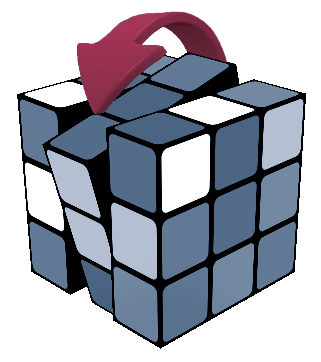
M: Middle layer like left face clockwise
There are three different slice turns that can be performed, but two of them are only ever used for Fewest Move Count. M moves are like L moves, but with the middle slice. If you wanted to perform an L’ move, you’d turn the left face counter-clockwise 90 degrees. For an M’ move, you do the same but with the middle slice. The animation shows an M’ move followed by an M move.
However, this isn’t the only middle slice. There are also E and S moves (these are the two only used for FMC). An E move follows the D layer in the same way that an M move follows the L layer, and an S move follows the F layer. The animations show and E’ followed by an E move and an S’ followed by an S move respectively.
Rotations are denoted by the axis the entire cube will be rotated by. Imagine a 3D axis. Y is represented by a vertical line, X by a horizontal line, and Z by a horizontal line perpendicular to X. Therefore a y rotation will rotate the cube around the top and bottom, x around the left and right, and z around the front and back. These rotations follow the U, R and F faces respectively, with y’ following a U’ move etc.
“Wide” moves are used on larger NxN puzzles with more than three layers. They follow the exact same format as standard 3x3 notation, except with a lower case W following the move, for example Rw. Using this example, an R move would be performed on the two right-most layers. The same applies for the largest move notation used by the WCA for 6x6 and 7x7 scrambles. 3Uw’ would represent a U’ turn on the three upper-most layers of the puzzle.
All of the above moves can be expressed either on their own, inverse (with a ‘ following it) or double (with a 2 following it).
Roux Method sub-steps (First Block, Second Block, CMLL and L6E)
Arguably the next most popular method after CFOP is Roux. Roux Method uses much different steps and algorithms to CFOP, and unless you are intending to learn it, these expressions aren’t really necessary for you to know. As long as you are vaguely familiar with them, you won’t get confused when you see them mentioned.
Inspection
This is more of a basic term, loosely used during casual speedcubing compared to the strict competition regulations about it. At the start of any official competition solve (excluding blindfolded and FMC solves) the solver is allowed 15 seconds to inspect the puzzle. With 3x3, this is normally used to plan the cross and maybe the first pair of F2L. At home, not many solvers go out of their way to time this, especially as it is timed by a judge in competition. However, some people like to experience the competition style of solving, whether it be to practice or just improve in general (this includes using the official Stackmat timers to time their solves instead of a keyboard). Most timers have the choice to use inspection time, for speedsolvers who still want to use the keyboard. Generally speaking, speedcubers rarely use all 15 seconds of inspection (in fact, sometimes it’s not even 7 seconds used), so this is why most speedcubers opt against using inspection.
Relays
Some people like to go beyond solving normally, but want to stick to the same puzzles. Enter relays. Puzzle relays can come in all shapes and forms, from a number of 3x3s consecutively to every cube owned by the solver. Relays have no limit to how crazy they can be. They are done simply by solving a number of different (or the same) puzzles consecutively without stopping the timer between them. Common relays include the 2-3-4 and the 2-3-4-5 relays. These involve solving pre-scrambled 2x2, 3x3 and 4x4 (and 5x5) puzzles in any order, ending the solve once all puzzles are solved.
Real Man Events
Real Man solves are gaining popularity within the community. They are solves that are performed in a different order to regular speedsolves. A regular solve would consist of scramble, start timer, solve, end timer. However, a Real Man solve starts the time, then scrambles the cube, then solves it, then stops the timer. It serves no other purpose than simple entertainment for those who like to scramble fast.
Guildford Challenge
The Guilford Challenge is an unofficial challenge created by UK Delegate for WCA Competitions Daniel Sheppard. It involves solving every official event except the BLD events in a row, ending the timer once all have been completed. This would be a heavy task for even the fastest of speedcubers, so the standard formats are 2-man, 3-man and 4-man. There is also a Mini Guildford challenge, which excludes some of the more obscure events.
Factory Solves
Factory Solves are normally done just for fun by speedcubers when they meet at competitions, however they are also done competitively by some individuals (despite being an unofficial event). It involves a scrambled cube for every solver (or sometimes just one cube between solvers), and after each step of the CFOP method, the cube is passed to the next person in the line. F2L is divided into the four pairs to create more steps, so the cube is passed along 6 times in total before the timer is stopped.
Team BLD
Team BLD (or Team Blind) involves two solvers, one blindfolded, taking a scrambled cube and solving it. With normal blindfolded solving, the solver would memorise the steps to solve the cube, don the blindfold and then attempt to solve using their memory. However, with Team BLD, one solver dons the blindfold immediately and the other person calls out the steps required to solve the cube. The blindfolded solver has to rely on the moves or cases described by the other person to solve the cube.
